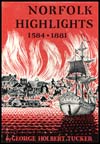Chapter 11
Everyday Life in Pre-Revolutionary Norfolk
For those of a later generation with a yen to know what everyday life in pre-Revolutionary Norfolk was like, it was fortunate that an old citizen with a good memory dropped in for a leisurely chat with the editor of the Norfolk Herald in the 1830s.
The result of the conversation was a delightfully detailed article headed "Old Times" that appeared in the Herald of January 7, 1835, by far the best preserved account of the people and the customs of the borough of that era. In those days, the old man recalled, Norfolk was a "rare place indeed," its harbor being "filled with ships swallowing up cargoes of innumerable little schooners and sloops from adjoining rivers laden with tobacco, wheat, corn, lumber, etc."
Pre-Revolutionary Norfolk society, according to the same source, was divided into three distinct classes. The top of the ladder was reserved for the clergy, doctors, lawyers, merchants, and "those who lived on their incomes." The next rung down was occupied by the town's many skilled artisans, who were, however, "respected in their class." At the bottom were the "canaille" or "tag-rag and bobtail."
Architecturally, the old man remembered, the Norfolk of his youth was not a place of beauty. A few substantial brick buildings like the Borough Church of 1739, the Norfolk County Court House, and the Mason's Hall, where Norfolk's upper crust occasionally tripped the light fantastic to the accompaniment of fiddles amid dripping tallow or wax candles, were outstanding.
In the main, however, the unlighted and unpaved streets and lanes were lined with warehouses or Dutch or hip-roofed, dormer-windowed houses with a chimney at each end and a passage in the middle, dividing the dining room from the "hall or withdrawing room." But despite this drabness, that didn't mean that pre-Revolutionary Norfolk was dedicated to all work and no play. And at election times or on the occasion of the town's annual fair on October 3 and the four following days, a rip-roaring time was usually had by all.
The Parade or Market Square, later known as Commercial Place, was always the center of these affairs that were marked by all sorts of horseplay.
At election times, the old man recalled, hogsheads of punch and grog with their heads knocked out and abundant supplies of ginger cakes were provided by the "headmen" of the opposing parties for the refreshment of their followers, while all bets at those times were decided at a tavern over an "infant," being a large china bowl of a two-gallow capacity.
The old man also recalled the lusty sports that characterized the fair-time diversions of his youth. At those times a well-soaped and greased pole would be set up in the center of the square, on top of which a "gold laced hat" would be placed as a prize for the "lucky dog" who could shinny up its slippery height and bring it down. At other times four nimble-footed damsels would run a race for a fine chemise; pigs would be turned loose in the milling crowd to be claimed by anyone who could catch hold of them by their shaved, greased tails; sack races were run by men encased in burlap bags up to their necks; or four lusty, and possibly half-drunk, fellows would race through three empty sugar hogsheads that had been laced end to end, resulting in a rolling and tumbling that made the spectators yell with glee.
Also in those pre-Society for the Prevention of Cruelty to Animals days, a bull was frequently baited by a pack of fierce dogs, a dangerous sport that usually sent the spectators scampering to the rooftops for safety.
Chapter
12
A Colorful Pre-Revolutionary Mayor
Norfolk Highlights 1584 - 1881

See the "Table of Contents" for links to every chapter in Norfolk Highlights 1584 - 1881 by George Holbert Tucker.
